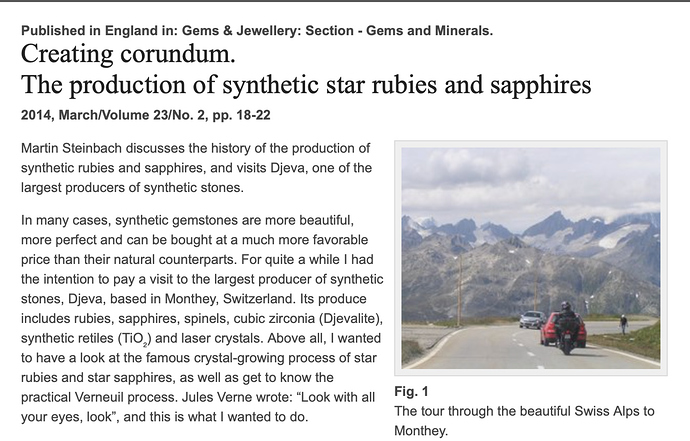Hi! I am a TV host for Jewelry Television Network, and I also work in Content Development for our company. I am trying to find a U.S.-based lab which produces synthetic gemstones so I can ask some questions and possibly even visit the facility to learn more about the gemstone creation process. In particular, I am interested in flame fusion, but any method/production process would be fabulous at this point. Does anyone know of a lab or knowledgeable synthetics expert I could contact? I really value the knowledge, networking resources, and expertise of the folks here in the IGS forum community, so any help on this project would be very greatly appreciated!
I can only make a comment to you at this time. I have a gem that I’ve been told is a flame fusion Ruby. Its 28+cts. It has a rich and deep blood red color, and sparkles brighter than most Diamonds can. I have had it for a while, and I bought it because I just simply wanted a really great looking big Ruby that I could afford. Only after this did find out all about what it was. I consider it to be well worth the price, but, its not a real Ruby. I show this gem around sometimes, but I don’t tell people that its a Ruby. They all believe it is. This stone is a certified man-made corundum gem. Why does anybody who wants a Ruby not want one of these ?? These stones are a good gem to have; even in some preferred piece of jewelry.
Tom C
One thing to remember, someone had to mine corundum somewhere in the world, then grind it to a powder, process it through a flame fusion process to get it to the state it could be cut int a fabulous gem.
The chemical formula for corundum “Al2O3” aluminum oxide is the same for both natural and lab created!..The same circumstances apply to mined diamonds and lab created diamonds, the chemical formula is "C’, carbon crystal!
Hi Tom, and thanks for your response. As a gemologist with both my GG and FGA degrees, a former attorney, and 30+ years in the jewelry industry, I wanted to just clarify one point you made for forum members’ reference:
- You mentioned that “it’s not a real Ruby.” In reality, it is! And this is not just my opinion: the FTC (Federal Trade Commission) has strict guidelines about what is and isn’t a gemstone, and their ruling on synthetic gemstones is that a synthetic or lab-grown ruby IS an actual ruby. This is because a synthetic ruby has essentially the same chemical, physical, and optical properties as a natural or “mined” ruby. In other words, f you were to grind up two rubies, one from the ground and one created in a lab and send the powder to a grading facility like GIA’s lab, both gems would be identified as “ruby”.
Here’s a video I made about how to tell the difference between a natural vs. a synthetic ruby that might help to explain better than I have here:
Hi rockrat! Thanks for your reply. I think you meant to write “chromium”, the coloring agent in ruby, rather than “corundum” in your first sentence. In general, the ingredients for a synthetic gemstone are not derived from natural stones - you can combine aluminum powder and oxygen with a trace impurity to create synthetic corundum.
Another process you may be referring to is that of lead glass filler, where natural corundum is ground up and then mixed/suspended in lead glass…this creates a beautiful gem with intense color and great clarity, but it is usually not considered a “synthetic”. Most folks in our industry still call it a natural, yet treated, corundum gem. (Others might say it is a glass which contains corundum for its coloring elements. This is especially true if there is a higher percentage of glass than corundum in the stone.)
Incorrect. Alumina, synthetically produced aluminum oxide (Al2O3), is a white crystalline substance that is produced by refining bauxite, a mixture of hydrous aluminum oxides, aluminum hydroxides, clay minerals, and insoluble materials such as quartz, hematite, magnetite, siderite, and goethite. The aluminum minerals in bauxite can include: gibbsite Al(OH)3, boehmite AlO(OH), and, diaspore, AlO(OH).
Hi Gigi, you may find this useful: Creating corundum. The production of synthetic star rubies and sapphires
Thank you for correcting me, Mr. Bergman! It truly is an honor to learn this information from you, as I have followed your work for a very long time. In particular, your lecture on Ethiopian opal and its possible treatments has greatly impacted my own studies of this material. I can’t believe one of the most respected gemologists out there today responded to little old me!
Thank you also for the wonderful references you posted here…I will be sure to check them out ASAP! Thanks for taking the time to help others learn more about the fascinating field of synthetic gems!
A pleasure to be of service, Gigi!
I recently watched several videos on youtube discussing synthetics (along the road to various mines in Myanmar, madagascar, etc) so this discussion and your posts were most welcome. Thank you.

